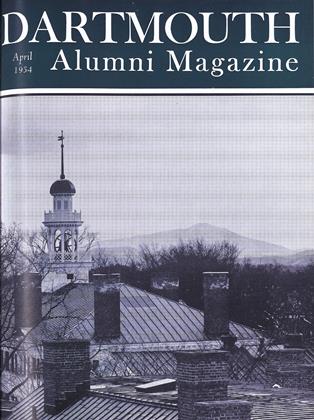BOTH O. Henry (The Fool Killer) and Stephen Vincent Benet (Johnny Pyeand, the Fool-Killer) did well with the American folk legend of the "fool killer," who comes to people who have behaved like fools to cut off their silly heads.
Now Helen Eustis, author of one of the finest mysteries of 1946, The HorizontalMan, has written on the legend in TheFool Killer, issued by Doubleday. This is the story of a twelve-year-old boy who runs away from his foster-parents in mid-America during the 1870's. The book has character and atmosphere, a beautifully sustained story, and a satisfying ending. In fact, it has a distinction rare in novels today. It is well written! Highly recommended.
Francis Steegmuller '27 has edited and translated a new volume in the Farrar-Straus-Young series of great letters (Keats, Cowper, Adams, Gray, Byron, etc.) called The Selected Letters of Flaubert. This volume spans Flaubert's whole career: his early journey to the Near East, Greece and Rome; his affair with Louise Colet; the composition of Madame Bovary and the effects of its publication; and the later years. The letters illumine his ideas on art and society and record something 0f his friendships with Victor Hugo, Turgenev, the brothers Goncourt, George Sand and Maupassant. I have enjoyed this book, and will continue to do so. We could do today with some of Flaubert's ideals on style!
Some time ago I reviewed here a his. torical novel by John Brick called TheRifleman. I have now read, with continued admiration for his objectivity and ability to maintain an exciting narrative based closely on historical fact, his new novel: The King's Rangers. This novel, especially interesting to any person living in New York State, tells of raids conducted by a special band of rangers under John and Walter Butler, and the Indian, Joseph Brant. When the Indians get out of hand and perpetrate a little Grade B massacre, it is not, the author argues, the fault of Butler. In fact, Brick says, the colonists would have used the Indians, too, if they had been able to enlist them on their side.
Most of the raids started from a British base at Niagara and penetrated deeply into the Mohawk and Susquehanna valleys of Central and Southern New York. The years range from 1777 to 1781. Most all the characters are real except the Tory Dan Millard, who was a friend of Walter Butler. Belle Montour, the half-Indian girl, did marry a man who may well have been something like Dan Millard.
This is a fast-paced story of the Revolution written from the Tory side. Kenneth Roberts did it in Oliver Wiswell, and now John Brick has done it again, and, I think, well.
If you are interested in the college generation of the present fifties, read C. G. Lumbard's novel about the University of California at Berkeley, called SeniorSpring (Simon & Schuster).
I hope you won't miss Colonel J. H. Williams' (Elephant Bill) new book about Bandoola, the wonderful Burma elephant, finally murdered by her keeper, who couldn't bear to think of anybody else being Bandoola's oozie (rider).
The Caine Mutiny may now be had in a 95-cent paper edition. And another papercovered book with wonderful illustrations and stimulating articles by Bertrand Russell ("Ideas That Have Helped Mankind"), Sean O'Casey ("The Arts Among the Multitude"), and Lewis Mumford ("Mirror of a Violent Half Century") and others, is called 7 Arts #2, and may be purchased for 50 cents. Both are published by Doubleday.
Never having taken economics in college, and not having seen a twenty dollar bill in twenty years, I have been fascinated and enlightened by reading EconomicsFor You and Me by our new Dean at Tuck School, Arthur Upgren, and Stahrl Edmunds. There are amusing line drawings, charts, and tables, which explain the dismal science in a way that even I could understand. And I mean it is very clearly written! Macmillan is the publisher.
I have recently re-read Sarah Orne Jewett's The Country of the Pointed Firs, available now in Anchor Books. Believe me, it is a genuine American classic. Maine is the locale. You simply must read it.
 View Full Issue
View Full Issue
More From This Issue
-
 Feature
FeatureAn Introvert at Dartmouth
April 1954 -
 Feature
FeatureADMISSIONS—SCHOLARSHIPS—ENROLLMENT
April 1954 By Robert L. Allen '45 -
 Article
ArticleThaddeus Stevens, 1814
April 1954 By JOHN S. MONAGAN '33 -
 Class Notes
Class Notes1918
April 1954 By ERNEST H. EARLEY, RICHARD A. HOLTON -
 Class Notes
Class Notes1921
April 1954 By REGINALD B. MINER, WILLIAM H. PERRY -
 Class Notes
Class Notes1915
April 1954 By PHILIP K. MURDOCK, MARVIN L. FREDERICK
HERBERT F. WEST '22
-
 Article
ArticleHANOVER BROWSING
January 1935 By Herbert F. West '22 -
 Article
ArticleHanover Browsing
December 1946 By HERBERT F. WEST '22 -
 Article
ArticleHanover Browsing
April 1947 By HERBERT F. WEST '22 -
 Books
BooksA CAMP AQUATIC PROGRAM,
June 1949 By Herbert F. West '22 -
 Article
ArticleHanover Browsing
May 1951 By HERBERT F. WEST '22 -
 Article
ArticleWestholm Publications
December 1956 By HERBERT F. WEST '22








